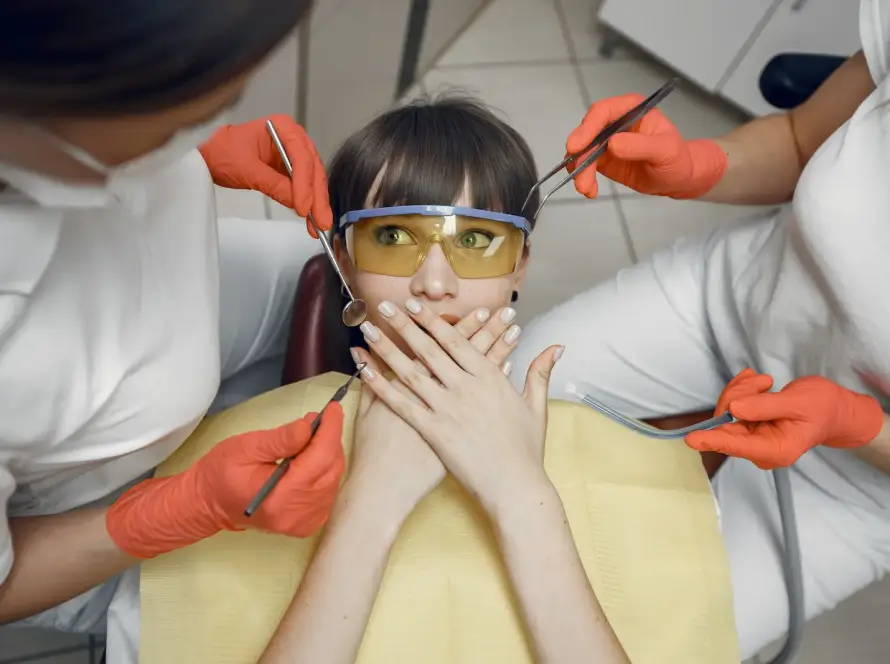Blue or Gray Teeth
Blue or gray teeth can be a source of concern and self consciousness for many people. Discoloration of the teeth can occur due to various factors such as genetics, medications, aging, and certain lifestyle habits. These discolorations can range from subtle shades of blue or gray to more pronounced and noticeable hues.
It is important to note that blue or gray teeth can be indicative of underlying dental issues that require attention. In some cases, it may be a sign of tooth decay, enamel erosion, or other dental conditions. Therefore, it is crucial to consult with a dental professional to determine the cause and appropriate treatment for blue or gray teeth.
In this article, we will explore practical ways to fix blue or gray teeth, with expert advice on various treatment options. Whether the discoloration is mild or severe, there are solutions available to help restore the natural color and brightness of your smile.
Understanding Enamel and Dentin
Enamel and dentin are the two main components of our teeth. Understanding these structures can help in identifying and treating blue or gray teeth.
- Enamel:
- Enamel is the outermost layer of the tooth, known for its hardness and resilience.
- It offers protection to the underlying structures and determines the tooth’s color.
- Blue or gray discoloration of teeth can be caused by thinning or erosion of enamel, allowing the darker dentin layer to show through.
- Dentin:
- Dentin lies beneath the enamel, providing support and structure to the tooth.
- It is naturally yellow in color and becomes more visible when enamel wears away.
- Blue or gray teeth may result from intrinsic stains within the dentin, such as from medications or trauma.
Understanding the properties and characteristics of enamel and dentin is crucial when addressing blue or gray teeth. Dentists can utilize this knowledge to determine the most appropriate treatment options for their patients.
Genetic and Developmental Factors
- Intrinsic tooth color: The natural color of teeth can be influenced by genetic and developmental factors. Some individuals may have naturally blue or gray teeth due to factors such as the thickness and translucency of the enamel, the density and composition of the dentin, or the presence of certain pigments.
- Amelogenesis imperfecta: This hereditary condition affects the enamel formation process, resulting in teeth that may appear discolored, pitted, or prone to chipping. Treatment options for amelogenesis imperfecta may include cosmetic procedures such as dental bonding, veneers, or dental crowns.
- Dentinogenesis imperfecta: Another genetic disorder that affects tooth development, dentinogenesis imperfecta, can cause the teeth to appear blue gray or even amber brown. Treatment for this condition may involve composite fillings, crowns, or other restorative procedures.
- Tetracycline staining: Exposure to the antibiotic tetracycline during tooth development can lead to gray or brown discoloration. This staining is often deeply ingrained in the tooth structure and may be challenging to treat. Professional teeth whitening, dental bonding, or veneers may be used to improve the appearance of tetracycline stained teeth.
- Hypoplasia: Enamel hypoplasia is a condition characterized by underdeveloped enamel, which can lead to teeth appearing yellow, brown, or gray. This condition may be caused by various factors, including genetics, poor nutrition, or illness during tooth development. Treatment options may involve enamel microabrasion, dental bonding, or veneers.
- Dental trauma: In some cases, injuries or trauma to the teeth during childhood can lead to discoloration later in life. These gray or blue gray spots can occur due to the death or damage of the tooth pulp. Treatments for such discoloration may include root canal therapy, dental crowns, or veneers.
It is essential to consult with a dentist or dental professional for a thorough evaluation and personalized treatment plan based on individual genetic and developmental factors. Proper diagnosis and professional guidance can help determine the most suitable approach to address blue or gray teeth effectively.
Medical Conditions and Medications
- Medical Conditions: Blue or gray teeth can sometimes be a sign of underlying medical conditions. Certain health issues, such as enamel hypoplasia, dentinogenesis imperfecta, or tetracycline staining, can cause tooth discoloration. Enamel hypoplasia refers to thin or incomplete enamel development, leading to blue gray spots or discoloration on the teeth. Dentinogenesis imperfecta is a genetic disorder that affects the tooth’s dentin, resulting in gray or brown discoloration. Additionally, the use of certain medications like antihistamines, antipsychotics, or chemotherapy drugs can also contribute to teeth discoloration.
- Medication Effects: Some medications can directly affect the color of your teeth. For example, tetracycline antibiotics, when taken during tooth development (usually in childhood), can lead to permanent gray or brown discoloration. Similarly, certain antihistamines, such as Benadryl, can cause teeth to appear yellow or darken. Other medications, such as antipsychotics or medications containing iron, can also cause tooth staining to varying degrees.
- Consultation with Healthcare Providers: If you suspect that your teeth discoloration may be related to an underlying medical condition or medication, it is essential to consult with your healthcare provider. They can evaluate your specific situation, review your medical history, and determine if any medical conditions or medications are contributing to the problem. This consultation will help you understand the root cause of your tooth discoloration and guide you toward the appropriate treatment options.
- Treatment Options: Depending on the specific medical condition or medication causing tooth discoloration, treatment options may vary. In some cases, addressing the underlying medical condition or adjusting medication dosages may help improve tooth color. However, for certain conditions like enamel hypoplasia or dentinogenesis imperfecta, specific dental treatments may be needed. These may include veneers, bonding, dental crowns, or professional teeth whitening procedures. It is crucial to discuss the available options with your dentist, who can recommend the most suitable treatment plan for your situation.
Note: It is essential to consult with a dental professional or healthcare provider before starting any treatment or making any changes to medication.
Dental Procedures and Treatments
When dealing with blue or gray teeth, there are several dental procedures and treatments that can help restore their natural appearance. Here are some practical ways to fix blue or gray teeth:
- Teeth Whitening: Professional teeth whitening treatments can effectively lighten the color of your teeth, including blue or gray shades. Dentists use various whitening techniques, such as bleaching agents or laser treatments, to remove stains and restore a brighter and whiter smile.
- Bonding: Dental bonding is a procedure where a tooth colored resin material is applied and bonded to the tooth’s surface. This can help cover up discoloration and improve the overall appearance of blue or gray teeth. Bonding is a quick and less expensive option compared to other restorative treatments.
- Veneers: Porcelain veneers are thin shells that are custom made and bonded to the front surface of the teeth. They can effectively cover up discoloration, including blue or gray shades, and provide a natural looking smile. Veneers are a more permanent solution and can also correct other cosmetic dental issues like chips or misalignment.
- Crowns: Dental crowns are tooth shaped caps that are placed over a prepared tooth to restore its shape, size, and color. Crowns can help cover up blue or gray teeth and provide a long lasting and natural looking result. They are often recommended for more severe cases of discoloration or when the tooth requires additional protection.
- Dental Implants: If the blue or gray tooth is severely damaged or cannot be effectively treated, dental implants may be an option. Implants are artificial tooth roots that are surgically placed into the jawbone and topped with a dental crown. They provide a permanent solution for replacing missing or severely discolored teeth.
It’s important to consult with a qualified dentist to determine the most suitable treatment option for your specific case of blue or gray teeth. They will evaluate the condition of your teeth, discuss your goals and preferences, and recommend the best course of action to achieve the desired results. Remember, maintaining good oral hygiene practices and regular dental check ups are crucial for the long term health and appearance of your teeth.
Lifestyle and Behavioral Factors
The color of our teeth can be impacted by various lifestyle and behavioral factors. By making certain changes and adopting healthy habits, it is possible to improve the appearance of blue or gray teeth. Here are some practical ways to address this issue:
- Quit smoking: Smoking not only affects your overall health but also stains your teeth. By quitting smoking, you can prevent further discoloration of your teeth and improve your oral hygiene.
- Limit coffee and tea consumption: The intense coloring agents in coffee and tea can lead to tooth discoloration. Reduce your intake of these beverages or rinse your mouth with water afterward to lessen their staining effects.
- Modify your diet: Certain foods and drinks, such as red wine, berries, and acidic beverages, can contribute to tooth discoloration. Limit your intake of these items or brush your teeth soon after consuming them.
- Maintain good oral hygiene: Brushing your teeth twice a day with a good quality toothpaste, flossing regularly, and using mouthwash can help remove surface stains and minimize discoloration.
- Visit your dentist regularly: Regular dental check ups and professional cleanings are crucial for preventing tooth discoloration and identifying any underlying dental issues.
- Consider teeth whitening treatments: If lifestyle changes and good oral hygiene practices don’t yield satisfactory results, consult a dentist about teeth whitening options like in office bleaching or at home whitening kits.
By incorporating these lifestyle changes and adopting proper oral hygiene practices, you can effectively reduce the appearance of blue or gray teeth and achieve a brighter, healthier smile.
Preventive Measures for Blue or Gray Teeth
To prevent the occurrence of blue or gray teeth, it is essential to follow a few preventive measures. Here are some expert recommended tips:
- Maintain good oral hygiene: Brush your teeth at least twice a day and floss regularly to remove plaque and prevent tooth discoloration.
- Use a soft bristled toothbrush: Opt for a soft bristled toothbrush to avoid enamel abrasion and tooth sensitivity.
- Avoid smoking and limit consumption of staining substances: Smoking and excessive intake of coffee, tea, red wine, and dark colored beverages can cause tooth discoloration. Try to minimize or avoid their consumption.
- Rinse your mouth after consuming staining foods or drinks: If you do indulge in staining foods or drinks, rinse your mouth or brush your teeth afterward to minimize the risk of discoloration.
- Regular dental check ups: Schedule regular dental check ups and professional cleanings to detect any early signs of tooth discoloration and address them promptly.
- Be cautious with acidic foods or drinks: Acidic foods and drinks can erode enamel, leading to tooth sensitivity and discoloration. Limit your intake of citrus fruits, sodas, and acidic beverages.
- Wear a mouthguard when playing sports: If you engage in contact sports or activities that pose a risk of dental trauma, wearing a mouthguard can help protect your teeth from damage and potential discoloration.
By implementing these preventive measures, you can reduce the chances of developing blue or gray teeth and maintain a healthy and vibrant smile.
Professional Treatment Options
When DIY remedies or over the counter products don’t provide the desired results, it may be time to consider professional treatment options for addressing blue or gray teeth. Dentists and dental professionals have access to advanced techniques and procedures that can effectively restore the natural white color of teeth. Here are some professional treatment options to consider:
- Professional teeth whitening: Dentists can perform in office teeth whitening procedures that involve applying a bleaching agent to the teeth and activating it with a specialized light. This can produce dramatic results in just one visit, effectively removing stains and discoloration.
- Porcelain veneers: Veneers are thin, custom made shells that are bonded to the front surface of the teeth. They can be used to hide discoloration and improve the overall appearance of the smile. Porcelain veneers are highly durable, stain resistant, and can provide long lasting results.
- Dental bonding: This procedure involves applying a tooth colored resin to the surface of the teeth and then shaping and polishing it to match the natural teeth. Dental bonding can be used to correct minor discoloration and restore a natural looking smile.
- Crowns: Dental crowns, also known as caps, can be used to cover severely discolored teeth. Crowns are custom made to match the color and shape of the patient’s natural teeth, providing a natural and attractive appearance.
- Gum depigmentation: Sometimes, the appearance of blue or gray teeth can be due to dark pigments in the gums. Gum depigmentation is a safe and effective procedure to remove these pigments and create a more uniform and pleasing gum color.
It is important to consult with a qualified dental professional to determine the best treatment option for your specific situation. They will assess the cause of the discoloration and recommend the most suitable treatment for achieving the desired results. With professional treatment options, patients can regain their confidence and enjoy a brighter, whiter smile.
Natural Remedies and Home Care
In addition to professional treatments, there are some natural remedies and home care techniques that can help improve the appearance of blue or gray teeth. Here are some expert recommended options:
- Oil Pulling: Oil pulling involves swishing coconut oil or sesame oil around in the mouth for about 15-20 minutes. This technique is thought to remove toxins and promote oral health, potentially helping to brighten the teeth.
- Baking Soda: Baking soda can be used as a mild abrasive to gently scrub away surface stains on the teeth. Mix a small amount of baking soda with water to form a paste, and brush onto the teeth using a soft toothbrush. Rinse thoroughly afterward.
- Hydrogen Peroxide: Diluted hydrogen peroxide can help to lighten the shade of blue or gray teeth. Mix equal parts of hydrogen peroxide and water, then use it as a mouthwash for about a minute. Spit it out and rinse with water afterward.
- Activated Charcoal: Activated charcoal has absorbent properties that can help remove stains from the teeth. Apply a small amount of activated charcoal powder to a damp toothbrush and gently brush the teeth for a couple of minutes. Rinse thoroughly afterward.
- Fruit Peelings: Rubbing the inside of banana, orange, or lemon peels on the teeth for a few minutes is believed to have a mildly whitening effect. However, be cautious with acidic fruits, as excessive use may damage tooth enamel.
It’s important to note that while these natural remedies may help enhance the appearance of teeth, they may not provide long lasting or significant results. Therefore, consulting a dentist is still advisable for a comprehensive evaluation and suitable treatment options.
Conclusion and Final Thoughts
In conclusion, there are several practical ways to fix blue or gray teeth and restore a brighter, more confident smile. Expert advice emphasizes the importance of identifying the underlying cause, whether it be intrinsic or extrinsic staining, and tailoring the treatment accordingly. It is crucial to consult with a dental professional who can provide a thorough examination and recommend the most suitable solution.
From professional teeth whitening procedures to cosmetic dentistry options like bonding or veneers, individuals have a range of effective treatments to choose from. Maintaining good oral hygiene habits, such as regular brushing and flossing, can also help prevent further staining.
Remember, every case is unique, and the right solution will depend on individual circumstances. It is always recommended to seek professional guidance to ensure safe and effective results. By addressing blue or gray teeth, individuals can regain their self confidence and achieve a radiant smile they can be proud of.















